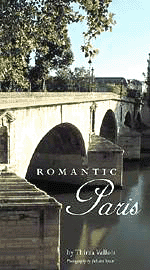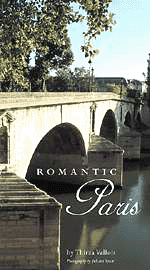Letter from Paris

- SUBSCRIBE
- ALREADY SUBSCRIBED?
BECOME A BONJOUR PARIS MEMBER
Gain full access to our collection of over 5,000 articles and bring the City of Light into your life. Just 80 USD per year.
Find out why you should become a member here.
Sign in
Fill in your credentials below.

Lately,
I have been shuttling back and forth between Paris and different parts
of the Aveyron, by air, by train and by car. What I haven’t done yet is
shuttle between London and the Aveyron, which is by far the cheapest
way to get there. Ryanair has been flying daily between Stanstead and
Rodez since May 2003, for, sometimes, as little as 5 euros. Of course,
the train ticket to get to Stansted Airport from London will cost you
some £20, but that’s besides the point-when advertising their super
bargains, you wouldn’t expect airlines to trumpet additional frills.
Still, even if you add them all up, it is cheaper to get from London to
Rodez than from Paris, adding to the ever-growing number of UK citizens
in the Aveyron, some of whom have made it their permanent home.
Most
foreigners I speak to have never heard of the Aveyron. When I tell them
I am in the midst of writing a book about it, their eyes brighten with
recognition. I always anticipate the blank expression that will follow
a few seconds later, when they realise that I didn’t say “Avignon” but
A-vey-ron, which I articulate very slowly this time round. The
Aveyron is tucked away on the southern edge of the Massif Central (the
central mountains of France), a very vast area of rugged surface
that makes it inaccessible (it takes seven hours to get from Paris to
Rodez by rail), and no TGV connection is planned for a foreseeable
future, because it will simply be too costly.
The
current policy of the SNCF (French Railway) is to run the TGV to a
nearby city (in the case of the Aveyron Toulouse or Montpellier) and
then connect it with a small regional train (TER), which is stylishly
designed (the way the French know how to do these things), but always
involves the hassle of a change. This also means that many local lines
are closing down, occasionally causing an outburst of protest, also
French-style. From the tourist’s perspective, however, why bother, when
other wonderful parts of France, like Provence, are so much faster to
get to? Except if he or she is one of those who can appreciate the
uniqueness of the Aveyron, which, for me, has been a perpetual song of
astonishment and a thrilling experience of rebirth.
Among
its multiple geographical features, due to a variety of climates and
geological complexity, are the northern highland pastures of the
Aubrac, which the Aveyron shares with the Cantal and the Lozère. The
Aubrac cattle is famous for both its beauty and the quality of its meat
and has not escaped the attention of the most upper circles of British
society. Among its fans is Sir John Eliot Gardiner, who, despite his
busy international career, makes time to breed Aubrac cattle on his
farm in Dorset, England and is a regular visitor at the annual spring
Transhumance, when the cattle make their way to the mountains for the
summer season. It so happens that this year is both the 100th
anniversary of the entente cordiale between England and France, and the
40th anniversary of Gardiner’s Monteverdi Choir.
It
so happens, too, that one of the four major pilgim routes to Santiago
of Compostela runs through the Aveyron starting in the Aubrac. It’s the
shortest of the four, but also the most beautiful one, starting at
Puy-en-Velay. Furthermore, this year happens to be une année
Jacquaire, that is, a year when Saint James’s Day falls on a Sunday,
which gives the pilgrimage extra momentum. This means there will be
many more pilgrims on the road throughout the summer, many of whom you
will recognise because they will be carrying the characteristic pilgrim
staff and sporting a coquille Saint Jacques by way of a brooch. The
other day, I even saw a donkey decorated with one which stuck out
exquisitely against its shining black coat.
Incidentally,
the gourmet coquille Saint-Jacques dish has its roots in the
pilgrimage. Upon arrival at Santiago in Galicia, the pilgrim would pick
scallops on the beach to take home as a token that he has completed the
pilgrimage. Later the scallop became a decorative motive often to be
seen carved on the walls of churches, sometimes on the pews. Next time
you are in Paris, before you rush to see the magnificent tapestries of
the Lady and the Unicorn, in the National Museum of the Middle Ages
(Hôtel de Cluny), take your time to look at the beautiful courtyard,
dripping with coquille Saint-Jacques carvings on a couple of its walls.
One of the four main pilgrim routes went through Paris, precisely
through rue Saint-Jacques, hence its name. It started at the church of
Saint-Jacques-de-la-Boucherie (so called because it served the
butchers’ community of Les Halles Central market), of which only the
tower has survived. You can see it north of place du Châtelet, at
present under scaffolding.
eventually make it to the Averyon, where crosses and other
paraphernalia from the medieval pilgrimage are sprinkled everywhere, go
and visit the church of Saint-Pierre-Saint-Paul in
Villeneuve-d’Aveyron, which houses14th-century murals depicting the
pilgrimage. Better still, if you can make it to the Aveyron in the last
week of this coming June, you will be able to listen to the Monteverdi
Choir perform in some of France’s most beautiful medieval churches,
Sainte-Foy in Conques (June 27th-an all-day event), the Cathedral of
Rodez (June 28th) the Abbey of Loc-Dieu (June 29th). Rehearsals are
open to the public at no charge, in three bejewelled country churches,
St-Pierre de Bessuéjouls, St-Austremoine and St-Jean-le-Froid, starting
on June 24th.
The surroundings are just as
enchanting, be it the conch-like topography of the gorgeous medieval
village of Conques, the grounds of Loc-Dieu which are worthy of an
English stately home, the tiny Jean-le-Froid perched on a mountain
blessed with bracing air and sweeping views, St-Austremoine, nestling
among the vineyards of the red valley of Marcillac, and St-Pierre de
Bessuéjouls, basking among the greenery of the happy valley of the
Lot. Not to mention the red-stoned cathedral of Rodez, sitting
proudly on a rock above the city, the capital of the Aveyron, whose
population, including the suburbs, reaches barely 50,000.
Bearing these figures in mind, you will have presumely gathered that you are seriously deep into la France profonde.
For further information: http://www.compostelle-gardiner.com. And for even more, turn to Thirza’s Around and About Paris, Volume I.
Thirza
Vallois is the author of Around and About Paris, Volume I, II, III
published by Iliad Books, UK. Romantic Paris, co-published by Interlink
Publishing Group, US and Arris Books, UK. Available at
http://www.thirzavallois.com. Her forthcoming book on the Aveyron is due to be published next year.


